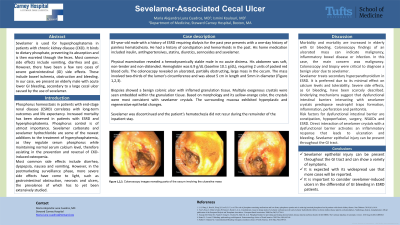Sunday Poster Session
Category: GI Bleeding
P0672 - Sevelamer-Associated Cecal Ulcer
Sunday, October 22, 2023
3:30 PM - 7:00 PM PT
Location: Exhibit Hall

Has Audio

Maria A. Luna Cuadros, MD
Steward Carney Hospital
Boston, MA
Presenting Author(s)
Maria A. Luna Cuadros, MD, Ismini Koulouri, MD
Steward Carney Hospital, Boston, MA
Introduction: Phosphorus homeostasis is critical in end-stage renal disease (ESRD), as it correlates with long-term outcomes and life expectancy. Sevelamer is a common treatment for hyperphosphatemia. Common side effects are diarrhea, dyspepsia, nausea, vomiting. More severe side effects are obstruction, necrosis and ulcers of the GI tract. A case of an elderly male with ESRD on dialysis and hyperphosphatemia treated with sevelamer, who had lower gastrointestinal bleeding is presented. Colonoscopy revealed a large ulcerative cecal mass consistent with an ulcer secondary to sevelamer.
Case Description/Methods: 83-year-old male with ESRD on hemodialysis comes with painless hematochezia. He had a history of constipation and hemorrhoids. His medications were insulin, antihypertensives, and sevelamer. Initial hemoglobin was 6.9 g/dL. A colonoscopy showed an ulcerated, partially obstructing, large mass in the cecum involving two-thirds of the lumen’s circumference and was about 5 cm in length and 5mm in diameter. Biopsies revealed a benign colonic ulcer with inflamed granulation tissue. Multiple exogenous crystals were embedded within the granulation tissue. Given their morphology and yellow-orange color, these were consistent with sevelamer crystals. Sevelamer was discontinued, hematochezia did not recur and hemoglobin remained stable for the remainder of his stay.
Discussion: Morbidity and mortality are increased elderly with gastrointestinal bleeding. Comorbidities and polypharmacy increase their risk of death. Colonoscopy findings of an ulcerated mass can indicate malignancy, inflammatory bowel disease or infection. Concerns for malignancy given age, hematochezia and constipation in this case. A colonoscopy and biopsy were critical to diagnose a benign ulcer due to sevelamer. Sevelamer treats secondary hyperparathyroidism in ESRD. It is preferred due to its minimal effect on calcium levels and its tolerability. Severe side effects, such as GI bleeding, have scarcely been described. Underlying mechanisms are not clear though it is suggested that dysfunctional intestinal barriers interacting with sevelamer crystals predispose neutrophil traps formation, inflammation, perforation and peritonitis. Risk factors for dysfunctional intestinal barrier are constipation, hypoperfusion, surgery, NSAIDs and ESRD. Direct interaction of sevelamer crystals with a dysfunctional barrier activates an inflammatory response that leads to ulceration and bleeding. Sevelamer epithelial injury can be present throughout the GI tract.

Disclosures:
Maria A. Luna Cuadros, MD, Ismini Koulouri, MD. P0672 - Sevelamer-Associated Cecal Ulcer, ACG 2023 Annual Scientific Meeting Abstracts. Vancouver, BC, Canada: American College of Gastroenterology.
Steward Carney Hospital, Boston, MA
Introduction: Phosphorus homeostasis is critical in end-stage renal disease (ESRD), as it correlates with long-term outcomes and life expectancy. Sevelamer is a common treatment for hyperphosphatemia. Common side effects are diarrhea, dyspepsia, nausea, vomiting. More severe side effects are obstruction, necrosis and ulcers of the GI tract. A case of an elderly male with ESRD on dialysis and hyperphosphatemia treated with sevelamer, who had lower gastrointestinal bleeding is presented. Colonoscopy revealed a large ulcerative cecal mass consistent with an ulcer secondary to sevelamer.
Case Description/Methods: 83-year-old male with ESRD on hemodialysis comes with painless hematochezia. He had a history of constipation and hemorrhoids. His medications were insulin, antihypertensives, and sevelamer. Initial hemoglobin was 6.9 g/dL. A colonoscopy showed an ulcerated, partially obstructing, large mass in the cecum involving two-thirds of the lumen’s circumference and was about 5 cm in length and 5mm in diameter. Biopsies revealed a benign colonic ulcer with inflamed granulation tissue. Multiple exogenous crystals were embedded within the granulation tissue. Given their morphology and yellow-orange color, these were consistent with sevelamer crystals. Sevelamer was discontinued, hematochezia did not recur and hemoglobin remained stable for the remainder of his stay.
Discussion: Morbidity and mortality are increased elderly with gastrointestinal bleeding. Comorbidities and polypharmacy increase their risk of death. Colonoscopy findings of an ulcerated mass can indicate malignancy, inflammatory bowel disease or infection. Concerns for malignancy given age, hematochezia and constipation in this case. A colonoscopy and biopsy were critical to diagnose a benign ulcer due to sevelamer. Sevelamer treats secondary hyperparathyroidism in ESRD. It is preferred due to its minimal effect on calcium levels and its tolerability. Severe side effects, such as GI bleeding, have scarcely been described. Underlying mechanisms are not clear though it is suggested that dysfunctional intestinal barriers interacting with sevelamer crystals predispose neutrophil traps formation, inflammation, perforation and peritonitis. Risk factors for dysfunctional intestinal barrier are constipation, hypoperfusion, surgery, NSAIDs and ESRD. Direct interaction of sevelamer crystals with a dysfunctional barrier activates an inflammatory response that leads to ulceration and bleeding. Sevelamer epithelial injury can be present throughout the GI tract.

Figure: Colonoscopy: Cecum views
Disclosures:
Maria Luna Cuadros indicated no relevant financial relationships.
Ismini Koulouri indicated no relevant financial relationships.
Maria A. Luna Cuadros, MD, Ismini Koulouri, MD. P0672 - Sevelamer-Associated Cecal Ulcer, ACG 2023 Annual Scientific Meeting Abstracts. Vancouver, BC, Canada: American College of Gastroenterology.
